Growing up in Indonesia, tempeh was a staple in my household. It was versatile, affordable, and packed with nutrition. My mother always ensured we had fresh tempeh from the local market, which became a core ingredient in our meals. But while tempeh could be prepared in many ways—grilled, stir-fried, or added to stews—nothing was as special as Tempe Mendoan.
Table of Contents

The process of making Tempe Mendoan was almost ritualistic. My mother would carefully slice the tempeh into thin rectangular pieces, mix the batter with just the right blend of spices, and heat the oil to the perfect temperature. She always knew when to flip the tempeh to achieve the ideal level of crispiness, ensuring that the batter remained light and airy while the inside stayed soft.
I still remember the anticipation as I waited for the first batch to come out of the pan. She would place the golden, fragrant pieces on a plate lined with banana leaves, serving them with sambal kecap—a simple but delicious dipping sauce made of sweet soy sauce, chopped chilies, and shallots.
For me, Tempe Mendoan was more than just a snack. It was a symbol of home and togetherness. Whenever guests visited, my mother would whip up a fresh batch, and it never failed to impress. Even now, as I make it in my kitchen, the familiar aroma and taste instantly transport me back to those cherished moments.
When I moved away from home, I struggled to find a Tempe Mendoan that tasted like the one I grew up with. The ones I saw in restaurants were often too thick, too greasy, or lacked the right blend of spices. That’s when I decided to master the art of making it myself. After experimenting with different types of flour, spice combinations, and frying techniques, I finally found the perfect balance.
Now, I want to share this experience with you so you can enjoy the authentic taste of homemade Tempe Mendoan wherever you are.
The Cultural and Historical Significance of Tempe Mendoan
To truly appreciate Tempe Mendoan, it’s important to understand its roots. The dish originates from Purwokerto, Central Java, and deeply connects to the local culinary culture.
What Does “Mendoan” Mean?
The name Mendoan comes from the Banyumasan Javanese dialect, where mendo means half-cooked or lightly fried. Unlike regular fried tempeh (tempe goreng), which is deep-fried until fully crispy, Tempe Mendoan is only fried briefly, resulting in a crispy batter but still soft inside. This unique cooking method gives it a distinctive texture that differentiates it from other tempeh dishes.
The Rise of Tempe Mendoan as a Popular Street Food
While Tempe Mendoan was traditionally homemade, it quickly became a popular street food across Indonesia. It is commonly found in warungs (small food stalls), markets, and roadside vendors. In cities like Purwokerto, Yogyakarta, and Jakarta, you can find vendors specializing in Tempe Mendoan, frying fresh batches on the spot.

Part of the appeal of Tempe Mendoan is its affordability and accessibility. Tempeh is one of Indonesia’s cheapest protein sources, making it an essential part of everyday meals. The simple yet flavorful batter, combined with the deep umami taste of tempeh, makes it a comfort food that people of all ages love.
Tempeh: A National Treasure of Indonesia
Tempeh itself has a fascinating history. It is one of the oldest plant-based proteins in the world, dating back to at least the 16th century in Java. Made by fermenting soybeans with Rhizopus mold, tempeh is delicious and highly nutritious. It is rich in protein, fiber, and probiotics, making it a favorite among vegetarians and health-conscious eaters worldwide.
Tempeh is more than just food—it’s a cultural heritage in Indonesia. The traditional method of making tempeh has been passed down for generations and remains a cornerstone of Indonesian cuisine. In 2021, Indonesia even submitted Tempeh as a candidate for UNESCO’s Intangible Cultural Heritage list, recognizing its significance to Indonesian identity.
Tempeh is often described as Indonesia’s gift to the world, and dishes like Tempe Mendoan showcase its versatility in the most delicious way.
What Makes Tempe Mendoan Special?
Now, you might be wondering: what makes Tempe Mendoan different from other fried tempeh dishes?
- Lightly Fried Instead of Deep-Fried
Unlike standard tempe goreng (fried tempeh), which is deep-fried until completely crispy, Tempe Mendoan is fried just until the batter sets, keeping the inside tender and soft. - Crispy Yet Soft Texture
The combination of corn flour, all-purpose flour, and spices in the batter gives Tempe Mendoan a delicate crispiness, but it remains light and airy rather than crunchy. - Bold, Aromatic Spices
A signature feature of Tempe Mendoan is its seasoned batter, infused with garlic, coriander, white pepper, and scallions. These spices enhance the natural umami of tempeh. - A Unique Regional Specialty
Though Tempe Mendoan is now popular across Indonesia, it remains a beloved specialty of Central Java, particularly in Purwokerto, where locals take great pride in their traditional preparation methods.

Why You Should Try Making Tempe Mendoan at Home
If you’ve never tried Tempe Mendoan, you’re missing out on one of the best Indonesian comfort foods! Here’s why you should give it a try:
✔ It’s Quick & Easy to Make – The batter comes together in minutes, and frying takes just a few minutes per batch.
✔ It’s Affordable – Tempeh is inexpensive, making this a budget-friendly dish.
✔ It’s Naturally Plant-Based – An excellent option for vegetarians and vegans.
✔ It’s Packed with Protein – A healthy and satisfying snack.
✔ It’s Incredibly Addictive – Once you taste it, you’ll keep coming back for more!
Whether you’re craving a crispy snack, looking for a plant-based protein option, or want to experience authentic Indonesian flavors, Tempe Mendoan is the perfect dish to add to your cooking repertoire.
Now that you know the history and cultural significance of Tempe Mendoan, let’s dive into how to make it step by step! In the next section, I’ll walk you through the ingredients, variations, and troubleshooting tips to ensure you always get the perfect Tempe Mendoan. 🍽️
Key Ingredients for the Best Tempe Mendoan
The secret to making the best Tempe Mendoan lies in its carefully selected ingredients. Each ingredient plays a specific role in enhancing the dish’s flavor, texture, and crispiness. Below, I’ll break down each ingredient and explain why it’s essential, along with tips on how to use substitutes if needed.
1. Tempeh (Tempe)
The star ingredient of Tempe Mendoan! Fresh, high-quality tempeh makes all the difference in the final dish.

✔ Why It’s Important:
- Provides a rich, nutty, umami-packed flavor.
- Absorbs the batter and seasonings beautifully.
- Has a tender yet firm texture, perfect for frying.
✔ How to Use It:
- Use fresh, firm tempeh, preferably homemade or from a local market.
- Slice into thin rectangular pieces (around 3mm thick).
- If using store-bought tempeh, steam it lightly before frying to remove bitterness.
✔ Substitutes:
- Firm tofu – can be used but won’t have the same depth of flavor.
2. All-Purpose Flour (Tepung Terigu Serbaguna)
All-purpose flour acts as the base of the batter, providing structure and ensuring the coating holds up during frying.
✔ Why It’s Important:
- It provides structure and prevents the batter from being too runny.
- It helps bind the spices, garlic, and starch together.
- Ensures a slightly chewy, satisfying texture when fried.
✔ How to Use It:
- Combine with corn starch for the perfect balance of crispiness and structure.
✔ Substitutes:
- Gluten-free flour blend – for a gluten-free version.
- Rice flour + tapioca flour – for a lighter texture.
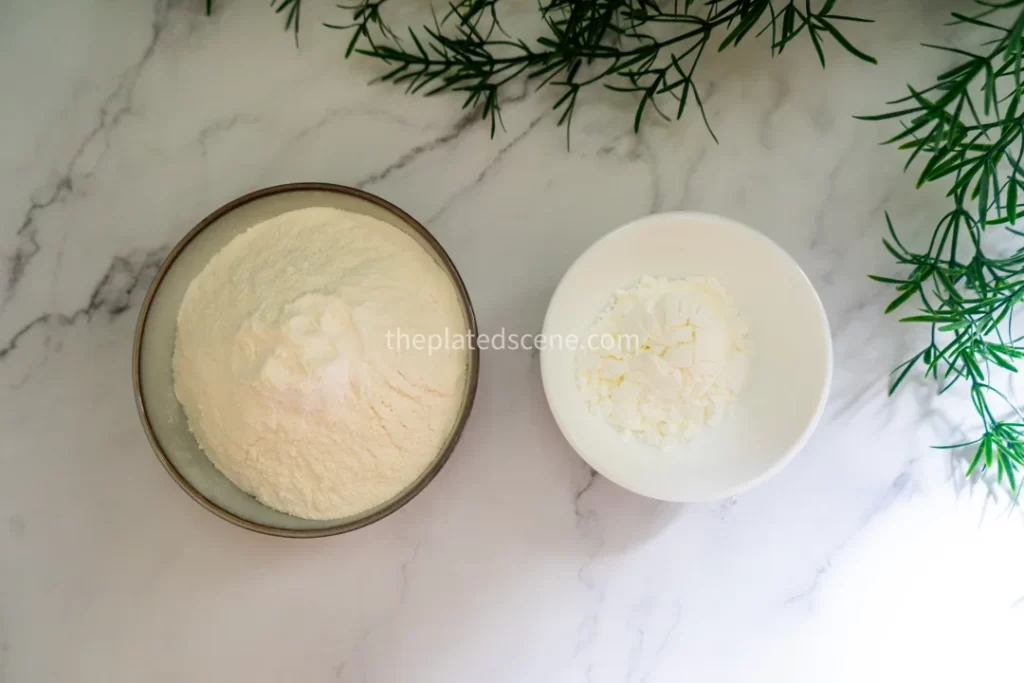
3. Corn Starch (Tepung Maizena)
Corn starch plays a key role in making Tempe Mendoan extra crispy. It helps create a light, delicate batter that doesn’t feel too heavy or greasy.
✔ Why It’s Important:
- Gives the batter a light, crisp texture.
- It helps the coating stick better to the tempeh.
- Reduces oil absorption, preventing greasiness.
✔ How to Use It:
- To be mixed into the batter.
- Do not substitute it entirely with all-purpose flour (you need both).
✔ Substitutes:
- Tapioca starch – works just as well.
- Rice flour – is another option for crispiness.
4. Scallion/Green Onion (Daun Bawang)
Scallions add a fresh, aromatic kick to Tempe Mendoan, giving it an extra layer of flavor.
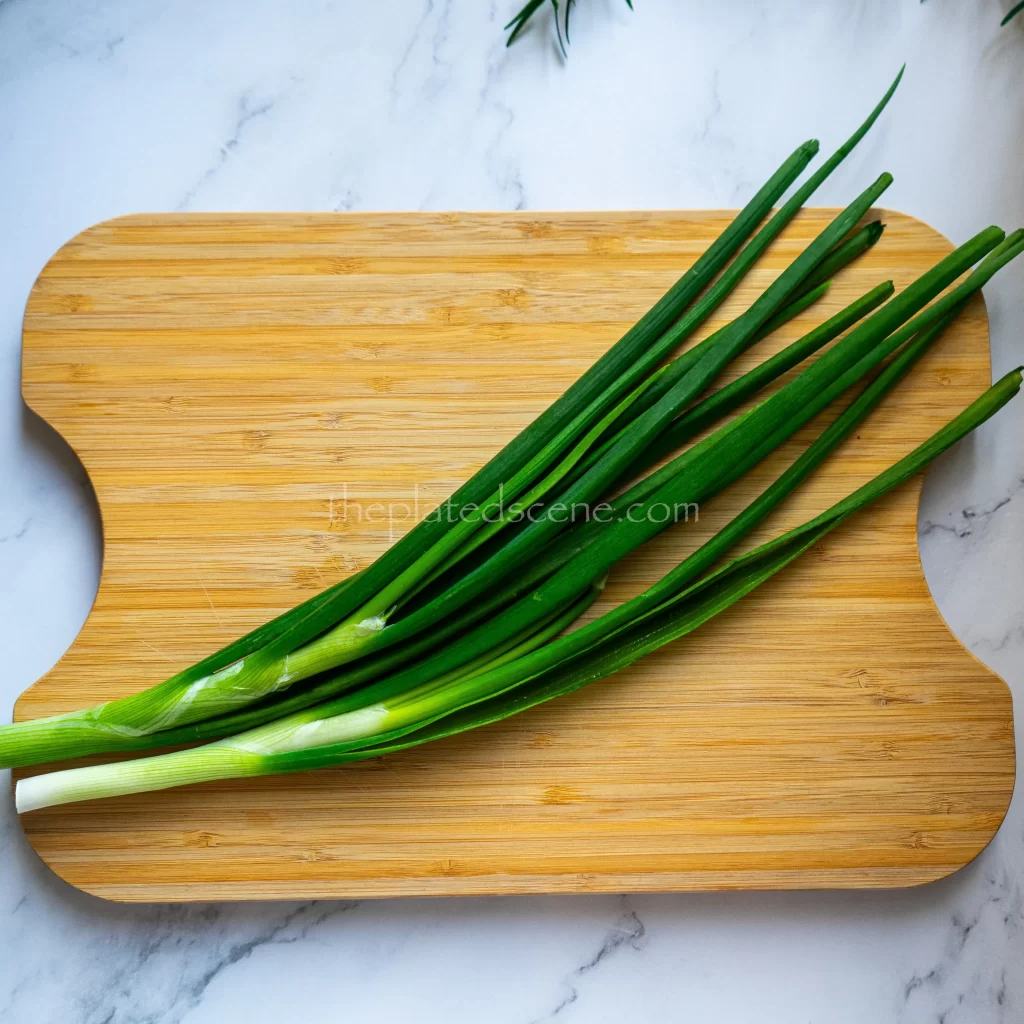
✔ Why It’s Important:
- Adds sweet, oniony flavor to the batter.
- Balances the rich, savory taste of tempeh.
- Gives the batter a beautiful green-speckled appearance.
✔ How to Use It:
- Finely chopped.
- Mix into the batter just before frying for freshness.
✔ Substitutes:
- Chives – similar mild onion flavor.
- Leeks – slightly stronger but works well.
5. Garlic (Bawang Putih)
Garlic is one of the most essential aromatics in Indonesian cooking. It provides a deep, savory umami flavor that enhances the natural taste of tempeh. In Tempe Mendoan, garlic is finely ground or mashed into a paste before being added to the batter.
✔ Why It’s Important:
- Adds rich umami depth to the batter.
- Balances the slightly nutty and earthy taste of tempeh.
- Gives the dish a distinctively Indonesian aroma when fried.
✔ How to Use It:
- Finely mince, mash, or grind into a paste before mixing it into the batter.
- Optionally, lightly fry the garlic first to mellow its sharpness.
✔ Substitutes:
- Garlic powder (½ teaspoon = 1 clove of garlic) – for convenience.
- Shallots – will add a slightly sweeter taste.
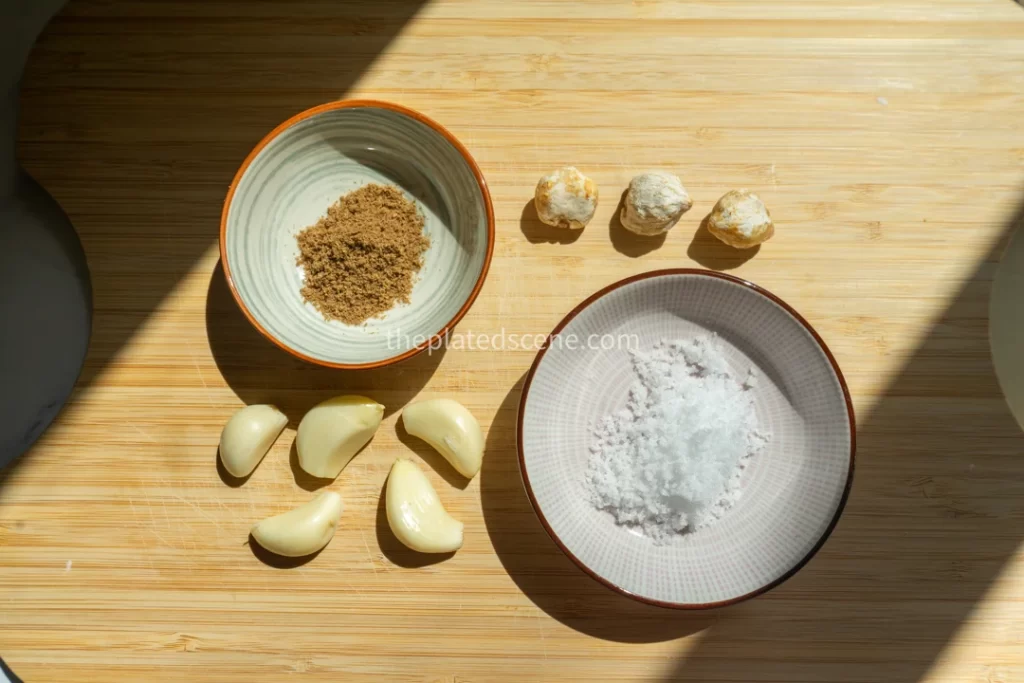
6. Candlenut (Kemiri)
Candlenut is a unique ingredient used in many Indonesian recipes. It has a buttery texture and provides a subtle creaminess to the batter. It’s often ground into a fine paste along with garlic before being added to the mixture.
✔ Why It’s Important:
- Enhances richness and depth of flavor.
- Helps create a slightly thicker, more textured batter.
- Works as a natural flavor binder, making the seasonings blend more smoothly.
✔ How to Use It:
- Lightly toasted and then ground.
- Blend with garlic and coriander for best results.
✔ Substitutes:
- Macadamia nuts – they have a similar creamy texture and mild taste.
- Cashews – can provide a similar richness.
- Skip it – if unavailable, the batter will still taste great.
7. Coriander Powder (Bubuk Ketumbar)
Coriander powder is an essential spice in many Indonesian fried foods, adding a distinctive warmth and citrusy aroma. It is a key ingredient in Tempe Mendoan, giving it that signature Indonesian street food flavor.
✔ Why It’s Important:
- Add a warm, slightly citrusy spice to the batter.
- Enhances the savory depth of garlic and tempeh.
- Gives Tempe Mendoan its authentic Indonesian taste.
✔ How to Use It:
- Use in the batter.
- If using whole coriander seeds, grind them fresh for maximum flavor.
✔ Substitutes:
- Cumin powder – similar warmth but slightly stronger.
- Omit it – if unavailable, but the dish will lack a key flavor note.
8. Salt (Garam)
Salt is a crucial seasoning in Tempe Mendoan, bringing out all the flavors in the batter and enhancing the taste of the tempeh itself.
✔ Why It’s Important:
- Balances the dish and enhances all the other flavors.
- Helps the batter stick to the tempeh properly.
- Bring out the natural umami of the garlic and candlenuts.
✔ How to Use It:
- Mix it directly into the batter for even distribution.
✔ Substitutes:
- Soy sauce can provide a similar saltiness to added umami.
- Sea salt or Himalayan salt – works just as well.
9. Cold Water (Air Dingin)
Cold water is a secret trick to making Tempe Mendoan extra light and crispy!
✔ Why It’s Important:
- Helps create an airy, delicate batter.
- Prevents the flour from over-developing gluten, making the coating lighter.
- Results in a fluffier, crunchier texture when fried.
✔ How to Use It:
- Stir gradually into the batter until smooth.
- Keep the batter chilled before frying for best results.
✔ Substitutes:
- Sparkling water or soda water – for an even airier batter.
- Milk – makes the batter richer but heavier.
Step-by-Step Guide to Making Authentic Tempe Mendoan
Now that we’ve covered the essential ingredients, let’s walk through the process of making Tempe Mendoan step by step. By following these detailed instructions, you’ll achieve the perfect balance of crispiness and softness, just like the traditional version found in Indonesian warungs.
Making Tempe Mendoan is straightforward, but each step is crucial in ensuring the best results. From properly slicing the tempeh to achieving the right batter consistency, these small details will make a big difference in the final dish. Let’s get started.
Step 1: Prepare the Tempeh
The first step is to cut the tempeh into thin, even slices.
How to cut the tempeh:
- Use a sharp knife to slice the tempeh into rectangular pieces about 3 millimeters thick.
- The thinness is important because Tempe Mendoan is meant to be soft inside, and slicing it too thick will make it challenging to cook properly.
- Keep the size consistent so that all pieces fry evenly.
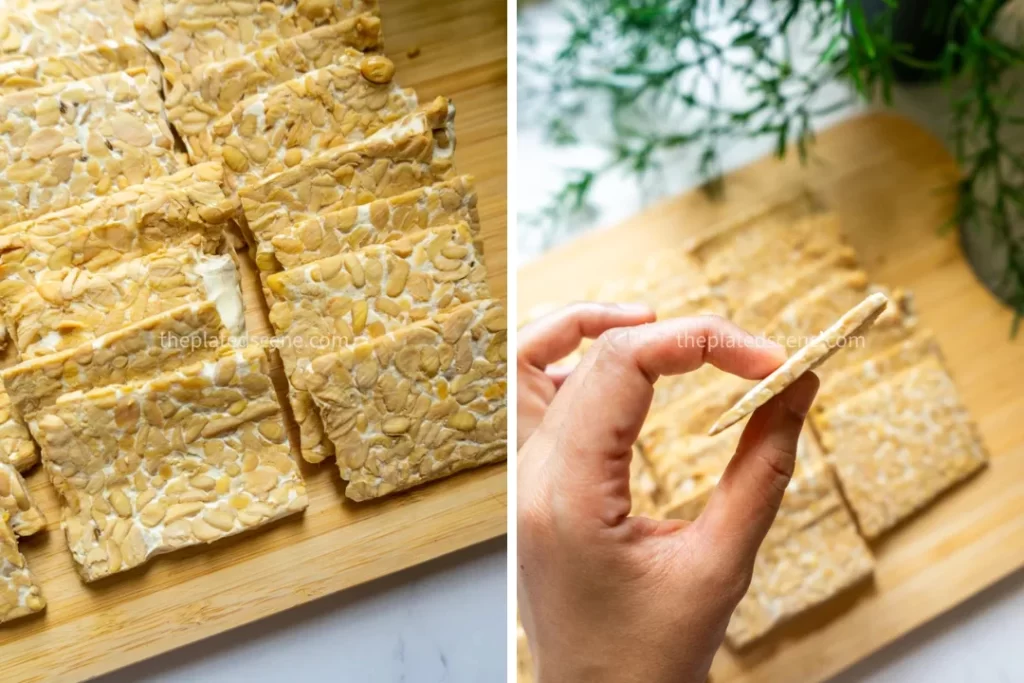
If you are using store-bought tempeh, you may notice a slight bitterness. To remove this, steam the tempeh for five minutes before slicing. This step is optional but helps improve the flavor, especially if the tempeh is slightly old or refrigerated.
Once all your tempeh slices are ready, set them aside while you prepare the other ingredients.
Step 2: Chop the Scallions
The next step is to chop the scallions, also known as green onions, finely.
How to chop scallions for Tempe Mendoan:
- Use only the green parts for a mild, aromatic flavor.
- Slice them finely to ensure even distribution in the batter.
- You’ll add the scallions directly into the batter later to give it a fresh, slightly sweet aroma.
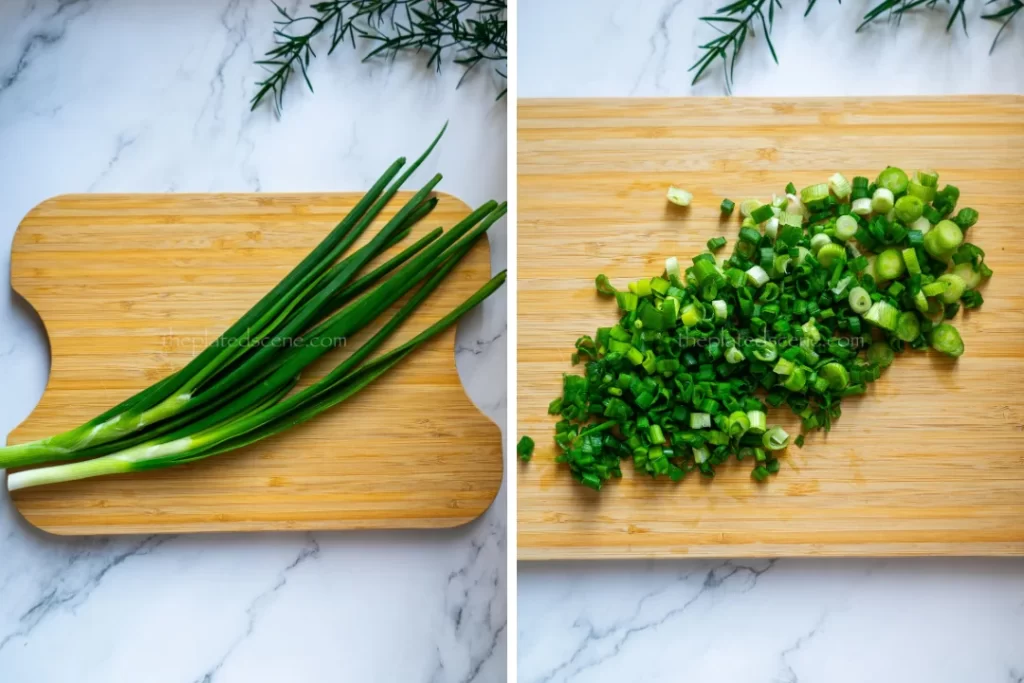
The scallions provide an extra layer of flavor without overpowering the tempeh. They also add a beautiful green-speckled appearance to the batter, making the final dish look more appetizing.
Once chopped, set the scallions aside for later use.
Step 3: Blend the Garlic and Candlenut
One of the secrets to the deep, savory flavor of Tempe Mendoan is the seasoned batter. This is achieved by blending garlic and candlenuts into a smooth paste. There are several ways to do this, depending on the tools you have available.
Option 1: Using a Mortar and Pestle (Traditional Method)
- Place two to three cloves of garlic and one to two candlenuts into a mortar.
- Use a pestle to grind them into a smooth paste.
- If the paste is too dry, add a teaspoon of water to help with blending.
This traditional method releases more natural oils and aroma, enhancing the flavor of the batter. It also gives a more textured, rustic paste, which some people prefer for Tempe Mendoan.
Option 2: Using an Immersion Blender (Modern Method)
- Add two to three garlic cloves and one to two candlenuts in a small bowl or measuring cup.
- Add one to two teaspoons of water to help with blending.
- Use an immersion (hand blender) to pulse until the mixture becomes smooth.
- If needed, scrape the sides and blend again to ensure even consistency.
This method is faster and more convenient, especially if you don’t have a mortar and pestle. It creates a smoother, more even paste, which blends easily into the batter. Here is the link for the hand blender that I use
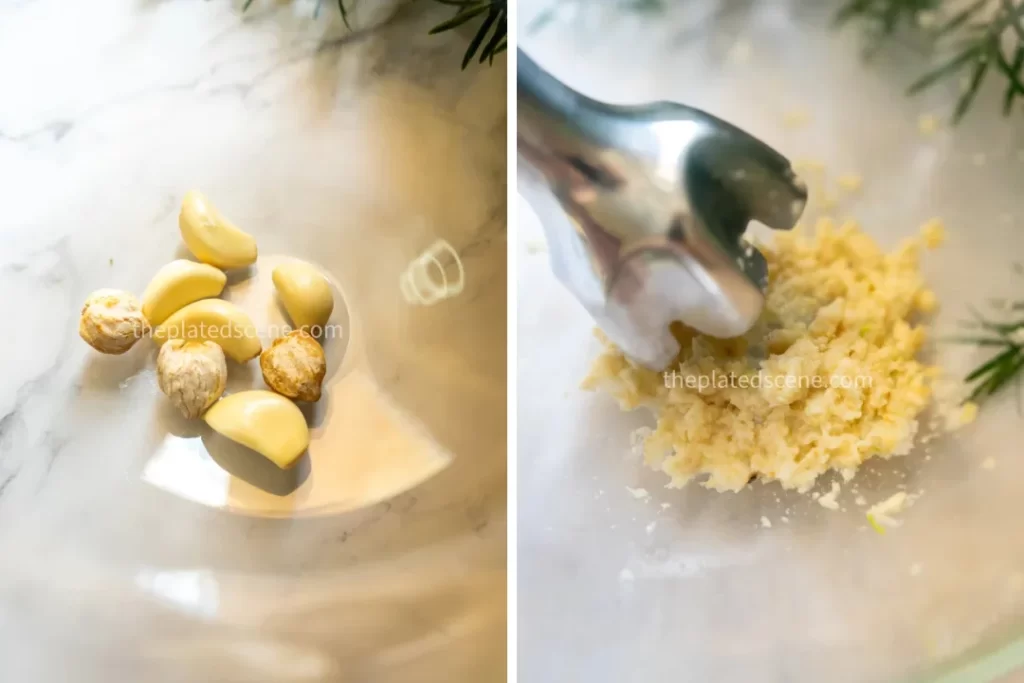
Option 3: Using a Small Food Processor or Spice Grinder
- Add garlic and candlenuts to a mini food processor or spice grinder.
- Add a few drops of water to help create a paste.
- Blend until smooth, scraping down the sides if needed.
This method is great for making larger batches of the paste if you are preparing multiple servings.
Once blended, set the paste aside and make the batter. No matter which method you choose, ensure the paste is as smooth as possible to distribute the flavors evenly in the batter.
Step 4: Make the Batter
The batter is what makes Tempe Mendoan so special. It should be light, flavorful, and crispy on the outside while keeping the inside soft.
How to make the perfect batter:
In a mixing bowl, combine:
- All-purpose flour for structure
- Corn starch for crispiness
- Blended garlic-candlenut paste for deep flavor
- Coriander powder for a warm, citrusy aroma
- Salt to enhance all the flavors
- Cold water to create a light, airy batter
- Finely chopped scallions for extra aroma and color
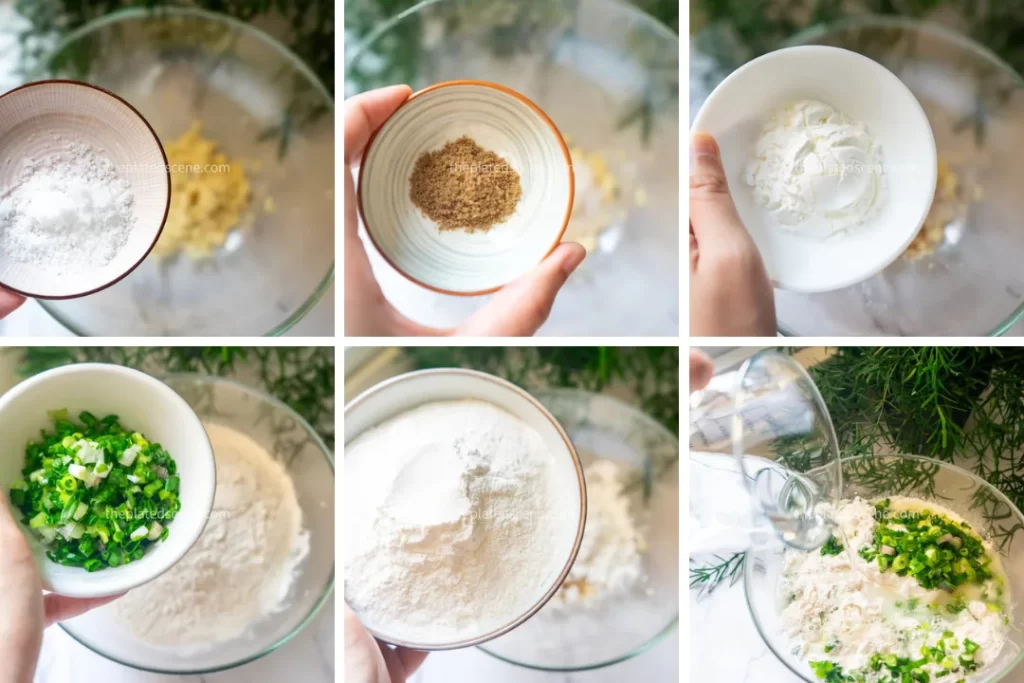
Use a whisk or spoon to combine all the ingredients until smooth. The batter should be slightly runny but thick enough to coat the back of a spoon. Avoid overmixing—stir until all ingredients are well combined.
Using cold water, or even ice water, helps keep the batter light and prevents it from absorbing too much oil during frying. Let the batter rest for five to ten minutes before using. This allows the flavors to develop and ensures a better texture when fried.
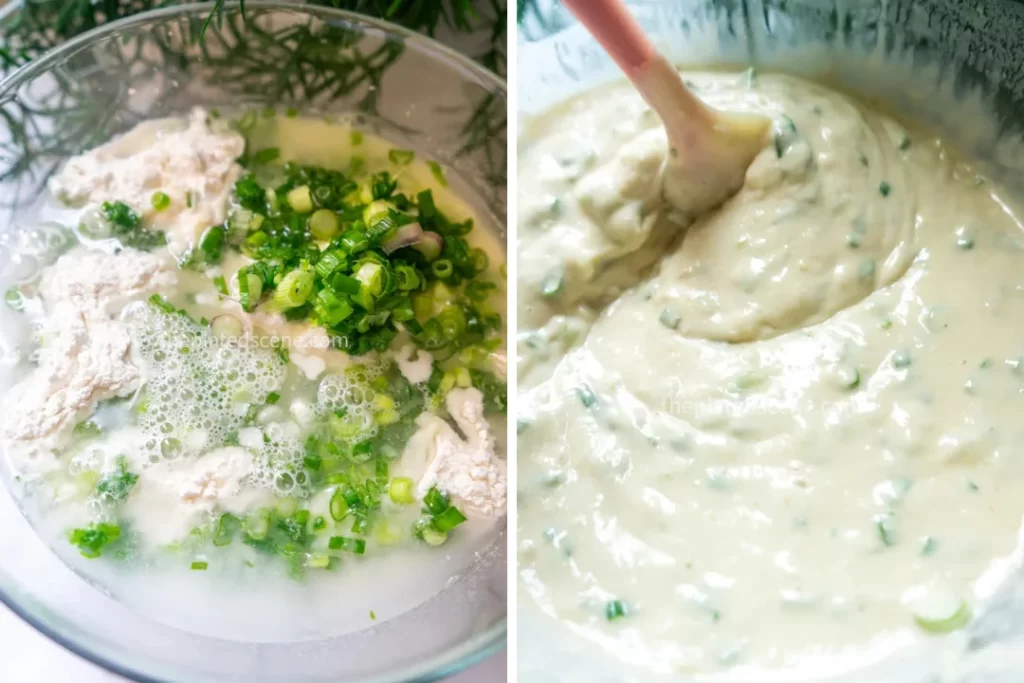
Once your batter is ready, it’s time to coat the tempeh.
Step 5: Coat the Tempeh in Batter
Now that the batter is ready, the next step is to coat the tempeh slices evenly before frying.
How to coat tempeh properly:
- Dip each tempeh slice into the batter, ensuring full coverage.
- Let the excess batter drip off before placing it in the oil.
- Avoid overcrowding the pieces in the batter—work in batches if necessary.

Even coating ensures that each piece has the right amount of crispiness. Too much batter can result in a thick, doughy coating that overpowers the tempeh. Letting the excess batter drip off helps achieve the perfect balance of crisp and soft textures.
Now, it’s time to fry.
Step 6: Fry the Tempe Mendoan
Frying is the most crucial step in getting Tempe Mendoan just right. Unlike other fried tempeh dishes, Tempe Mendoan is meant to be crispy on the outside but still soft and tender inside. You don’t want to deep-fry it until it turns golden brown like regular fried tempeh. Instead, the batter should remain light and slightly crisp, creating a delicate contrast with the soft tempeh inside.
Choosing the Right Oil for Frying
- Use a neutral oil with a high smoke point, such as palm oil, canola oil, sunflower oil, or vegetable oil. These oils won’t overpower the delicate flavors of the batter and tempeh.
- Avoid oils with intense flavors like olive oil or coconut oil, as they can interfere with the traditional taste.
- If using used frying oil, ensure it is clean and does not have a strong smell, as Tempe Mendoan easily absorbs odors from old oil.
Setting the Right Oil Temperature
- The ideal frying temperature is around 170°C (340°F).
- If the oil is too hot (above 180°C/356°F), the batter will burn quickly before the tempeh inside can warm through.
- If the oil is too cold (below 160°C/320°F), the batter will absorb too much oil, making the tempeh greasy and heavy instead of light and crispy.
- To check if the oil is at the right temperature, drop a small spoonful of batter into the oil. The oil is ready if it sizzles and rises immediately but doesn’t turn brown too quickly.
Frying the Tempeh Correctly
- Prepare the frying pan or deep fryer – Pour in enough oil to submerge at least half of the tempeh slices. A shallow fry works best because Tempe Mendoan is not meant to be fully submerged like deep-fried foods.
- Work in batches – Do not overcrowd the pan; this will lower the oil temperature and make the tempeh soggy.
- Place the battered tempeh gently into the oil – Avoid splashing by lowering the tempeh slowly into the oil using tongs.
- Fry for about 1 to 2 minutes per side – Flip the tempeh gently halfway through cooking. The batter should turn a light golden but remain soft and slightly translucent in some spots.
- Check the crispiness – The edges should feel slightly crispy, but the tempeh should remain tender when pressed.
- Remove and drain properly – Use a slotted spoon or tongs to remove the tempeh from the oil. Place it on a paper towel-lined plate or a wire rack to drain excess oil.

How to Keep Tempe Mendoan Light and Crisp
- If the first batch absorbs too much oil, your batter might be too thick. Add a little more cold water to thin it out.
- If the batter is too thick, it will create a heavy coating that doesn’t crisp up properly. The perfect batter should lightly coat the tempeh without dripping excessively.
- If you want extra crispiness, refry the tempeh for a few seconds just before serving. A second fry will help remove excess moisture and make the outer layer crunchier.
Avoiding Common Frying Mistakes
1. The batter falls off the tempeh while frying
- Make sure the tempeh is dry before dipping it into the batter. If it has excess moisture, the batter won’t stick well.
- Let the batter rest for 5 to 10 minutes before dipping the tempeh. This allows the flour to absorb the water, creating a better coating fully.
2. The tempeh turns too brown too quickly
- Reduce the heat and check the oil temperature. You might be frying at too high a temperature.
3. The tempeh is too greasy
- Make sure the oil is hot enough before frying. If the oil is too cold, the batter will soak up too much oil, making it heavy and greasy instead of light and crisp.
- Always drain the tempeh properly after frying. Letting it sit in excess oil will cause it to become soggy.
Serving Fresh for Best Taste
Tempe Mendoan is best eaten fresh, right after frying. The crispiness starts to fade as it cools, so try to serve it immediately. If you need to store it later, reheat it in an air fryer or oven at 180°C (350°F) for 5 to 7 minutes to restore some crispiness.
By following these tips, you’ll achieve the perfect Tempe Mendoan—crispy on the outside, tender on the inside, and bursting with flavor. Now, all that’s left to do is serve and enjoy!
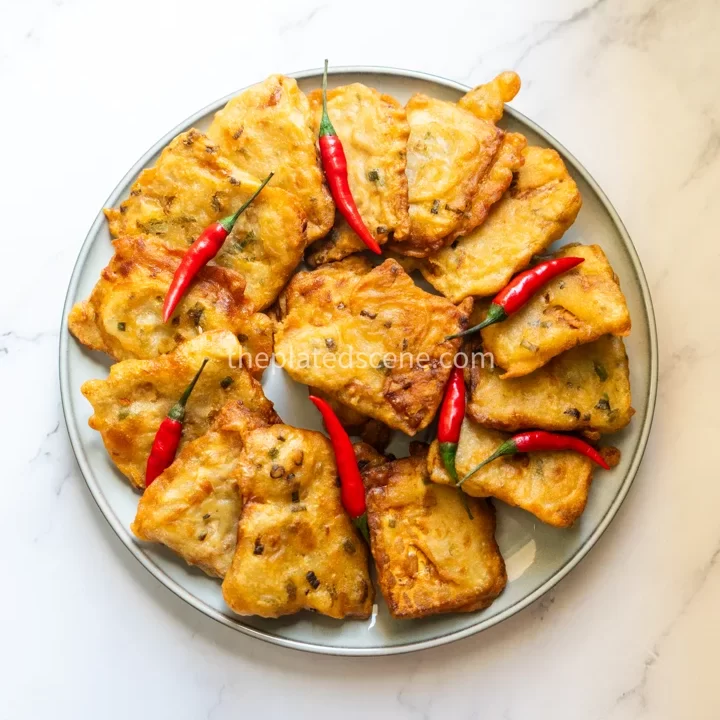
Other Tempeh Recipes
If you love tempeh, you might enjoy these other delicious Indonesian tempeh dishes:
- Kering Tempe – Crispy, sweet, and savory fried tempeh coated in a caramelized spiced glaze. Perfect as a snack or side dish.
- Terik Tahu Tempe – A rich, coconut milk-based braised tempeh and tofu dish with aromatic Javanese spices.
- Tahu Tempe Bacem – A sweet and savory marinated tempeh and tofu dish, slowly braised in palm sugar and spices before being lightly fried.
Pairing Recommendations
Pair your Tempe Mendoan with these complementary Indonesian dishes for a complete meal:
- Ketoprak – A delicious Jakarta-style salad with rice cakes, bean sprouts, vermicelli noodles, and a rich peanut sauce. The perfect balance of textures and flavors.
- Gulai Nangka – A fragrant jackfruit curry simmered in coconut milk and aromatic spices, adding a rich and slightly spicy element to your meal.
- Sayur Bening Bayam – A simple and refreshing spinach soup with clear broth, infused with garlic and aromatic lemongrass. A light side dish to balance the crispy Tempe Mendoan.
These dishes complement Tempe Mendoan beautifully, offering a mix of textures, flavors, and nutrition. Let me know which pairing you try first!
Now that you have the perfect Tempe Mendoan recipe, it’s time to try making it yourself! Whether you enjoy it as a snack or pair it with your favorite Indonesian dishes, this crispy yet soft tempeh will quickly become a favorite.



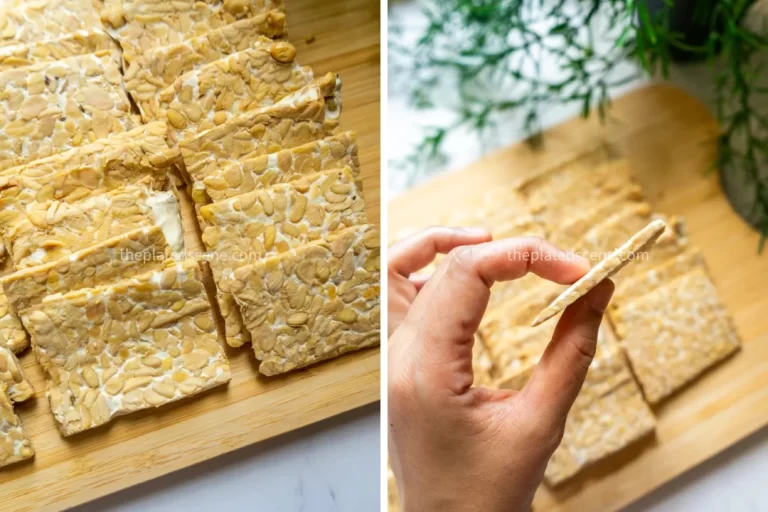 If you are using store-bought tempeh, you may notice a slight bitterness. To remove this, steam the tempeh for five minutes before slicing. This step is optional but helps improve the flavor, especially if the tempeh is slightly old or refrigerated. Once all your tempeh slices are ready, set them aside while you prepare the other ingredients.
If you are using store-bought tempeh, you may notice a slight bitterness. To remove this, steam the tempeh for five minutes before slicing. This step is optional but helps improve the flavor, especially if the tempeh is slightly old or refrigerated. Once all your tempeh slices are ready, set them aside while you prepare the other ingredients.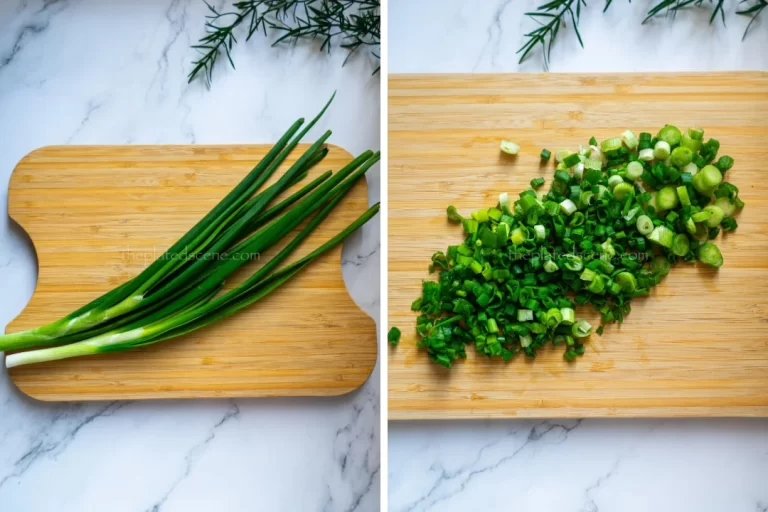
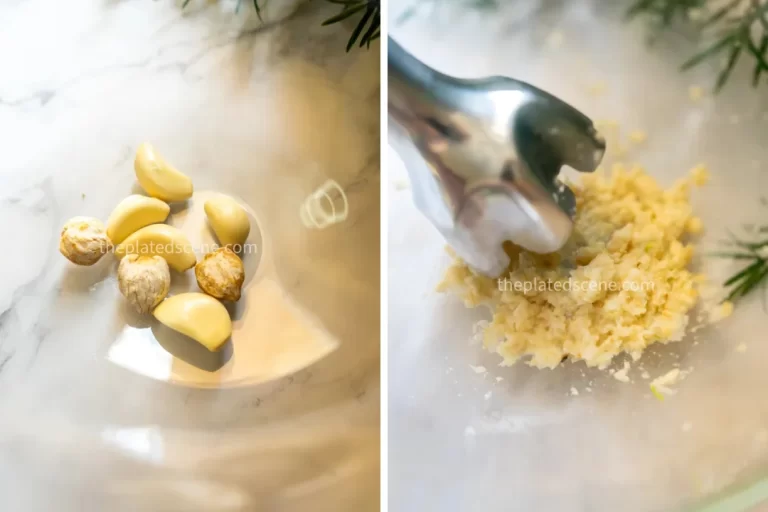 Option 3: Using a Small Food Processor or Spice Grinder
Option 3: Using a Small Food Processor or Spice Grinder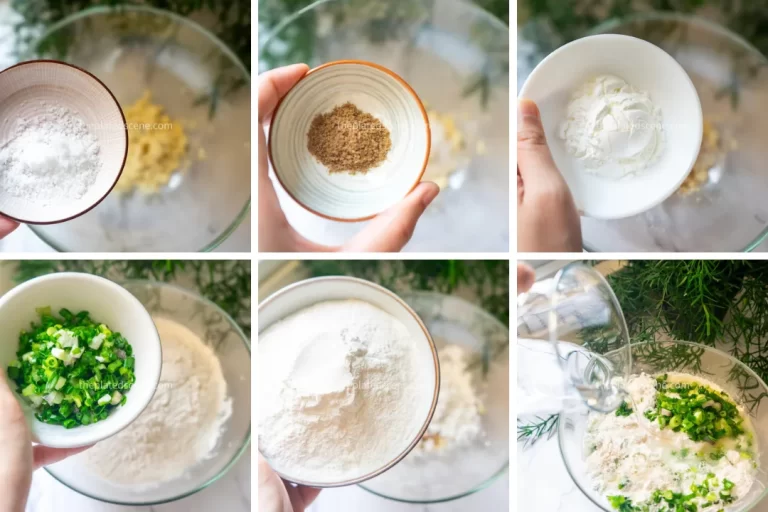 Use a whisk or spoon to combine all the ingredients until smooth. The batter should be slightly runny but thick enough to coat the back of a spoon. Avoid overmixing—stir until all ingredients are well combined.
Use a whisk or spoon to combine all the ingredients until smooth. The batter should be slightly runny but thick enough to coat the back of a spoon. Avoid overmixing—stir until all ingredients are well combined.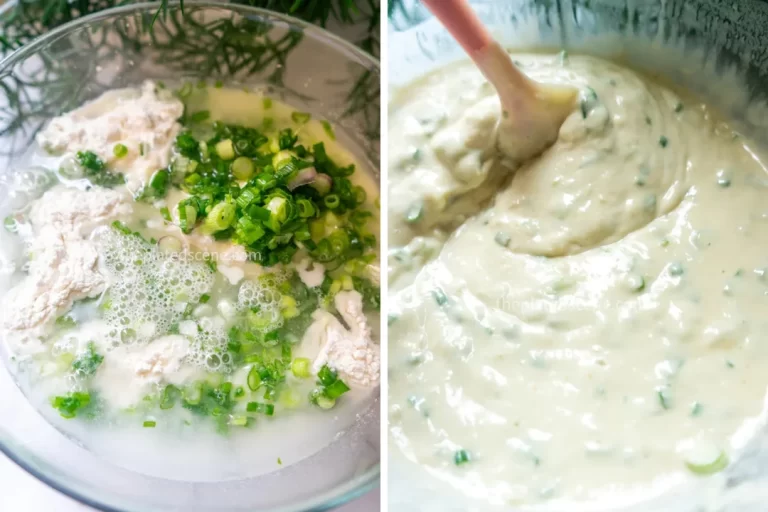
 Even coating ensures that each piece has the right amount of crispiness. Too much batter can result in a thick, doughy coating that overpowers the tempeh. Letting the excess batter drip off helps achieve the perfect balance of crisp and soft textures.
Even coating ensures that each piece has the right amount of crispiness. Too much batter can result in a thick, doughy coating that overpowers the tempeh. Letting the excess batter drip off helps achieve the perfect balance of crisp and soft textures.